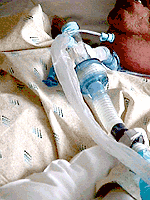Suction Catheter
What is a suction catheter?
A suction catheter is a flexible, long tube attached on one end to the breathing tube (endotracheal or tracheostomy tube). The other end of the suction catheter is connected to a collection container (suction canister) and a device that generates suction.
When is a suction catheter used?
Critically ill or injured patients who require a breathing (endotracheal) tube or tracheostomy tube need occasional suctioning to remove secretions from the airway. The respiratory therapist, nurse, or ICU technician suctions a patient by inserting a small flexible tube called a suction catheter into the breathing tube. The purpose of suctioning is to keep the airways clear of secretions and hopefully prevent plugging of the airways.
Does it hurt to use the suction catheter?
Most patients say yes. It creates an urge to cough and can cause a burning sensation in the lungs. Fortunately, the discomfort only lasts a short time.
How often is the suction catheter used?
The frequency of suctioning is determined by the amount of secretions that the patient produces. The breathing tube is suctioned whenever fluid builds up in the lungs.
 Suction catheter (bottom tube) attached to
endotracheal tube and suction device (not visible). The suction catheter is enclosed in a sterile plastic
sheath.
Suction catheter (bottom tube) attached to
endotracheal tube and suction device (not visible). The suction catheter is enclosed in a sterile plastic
sheath.